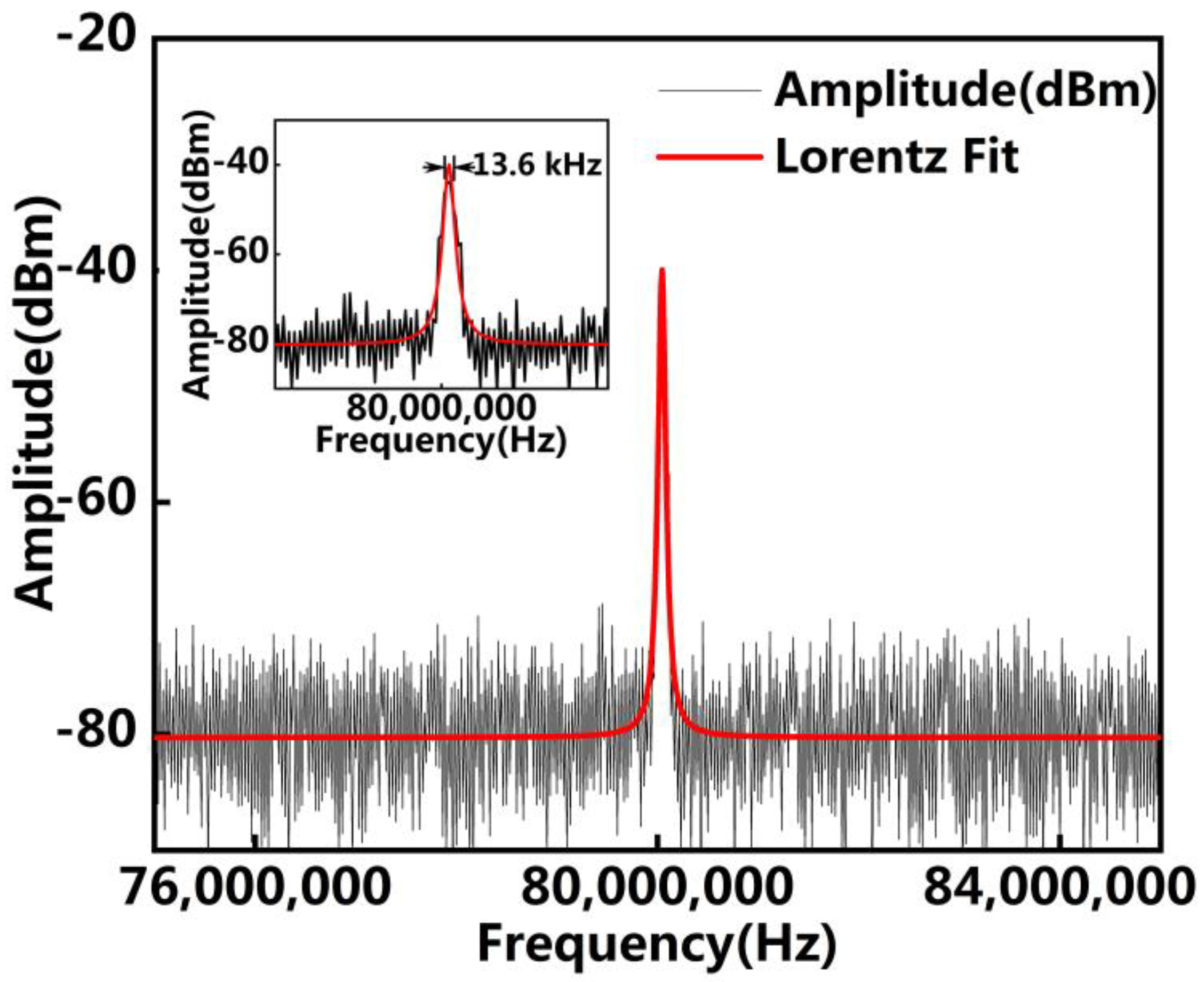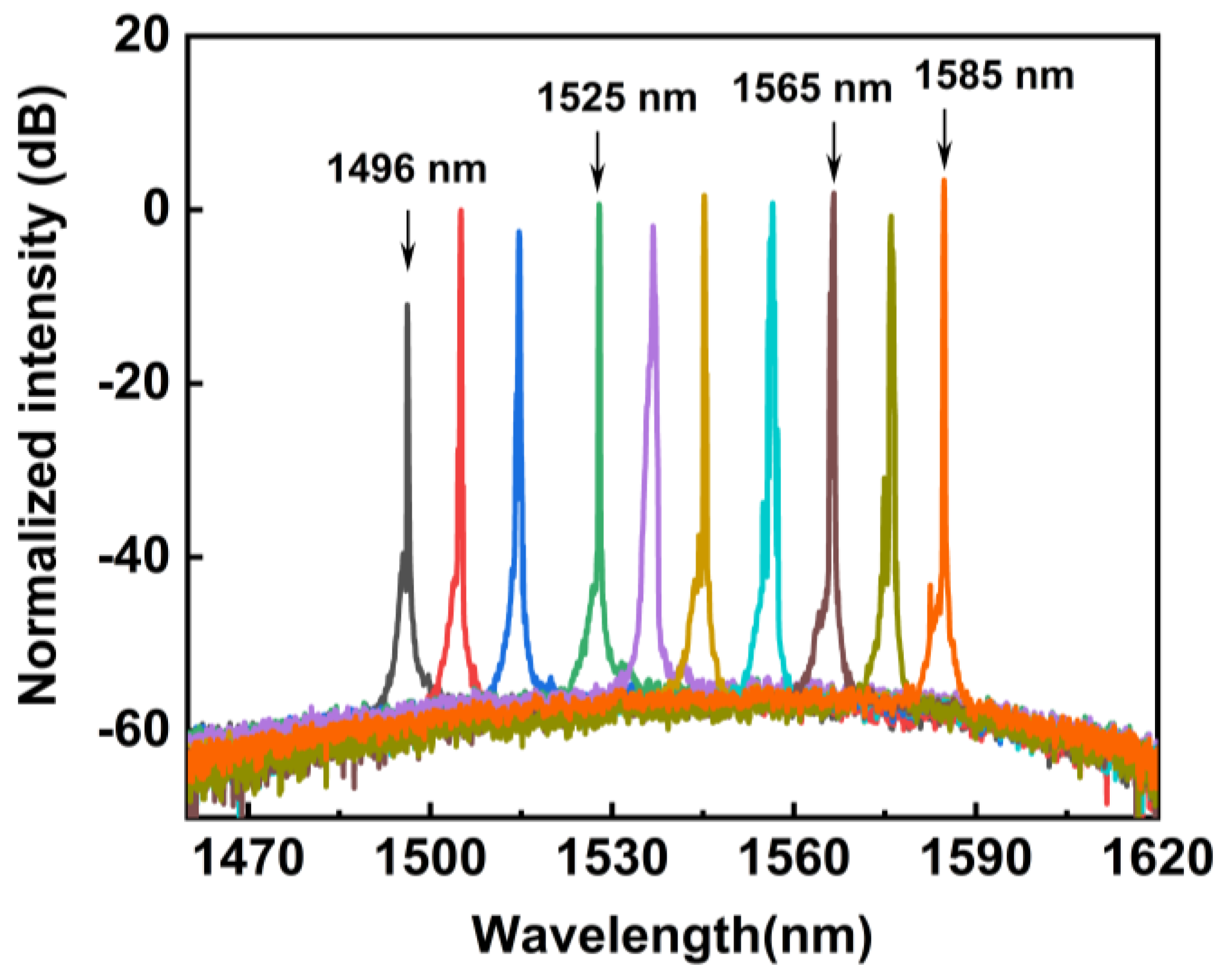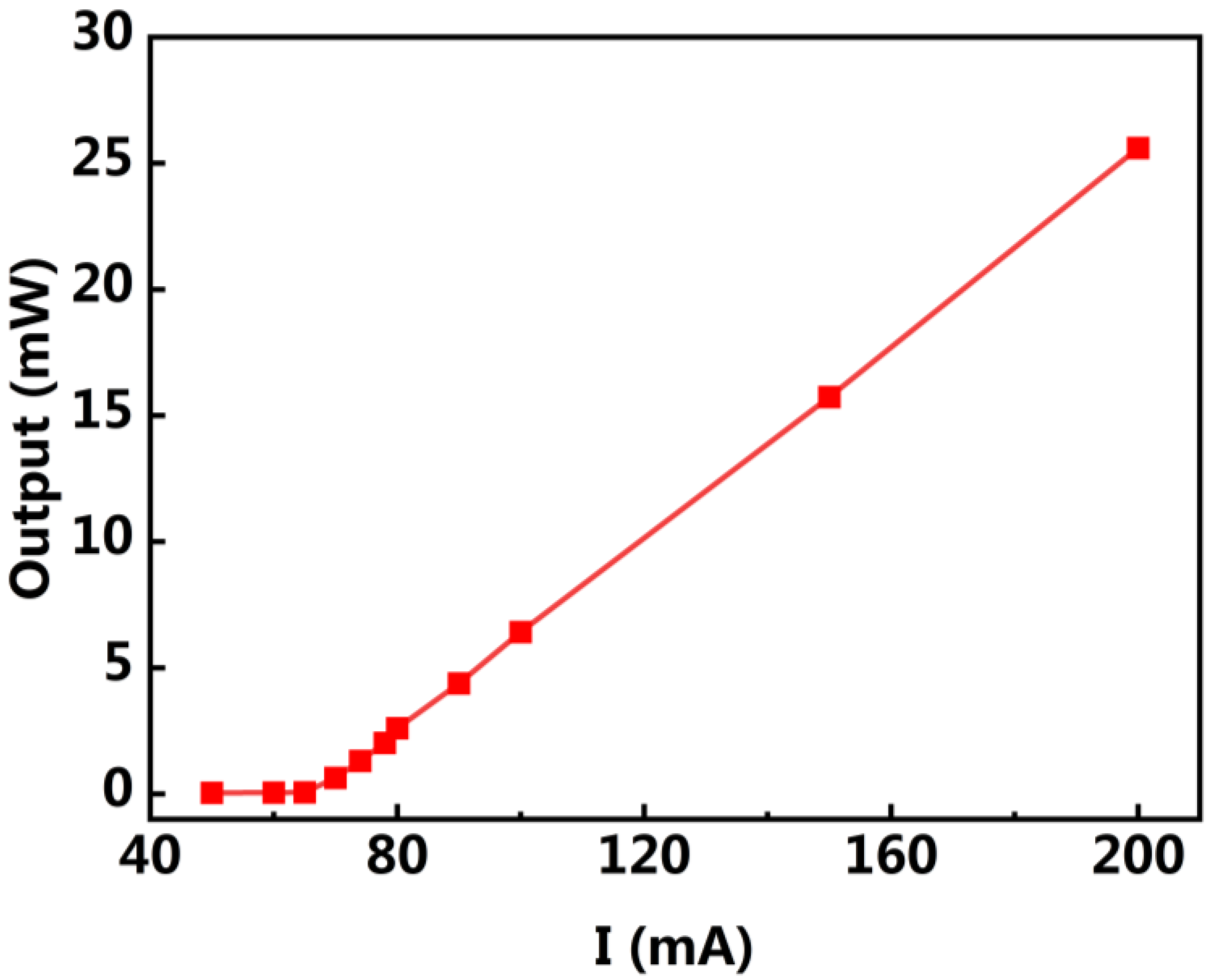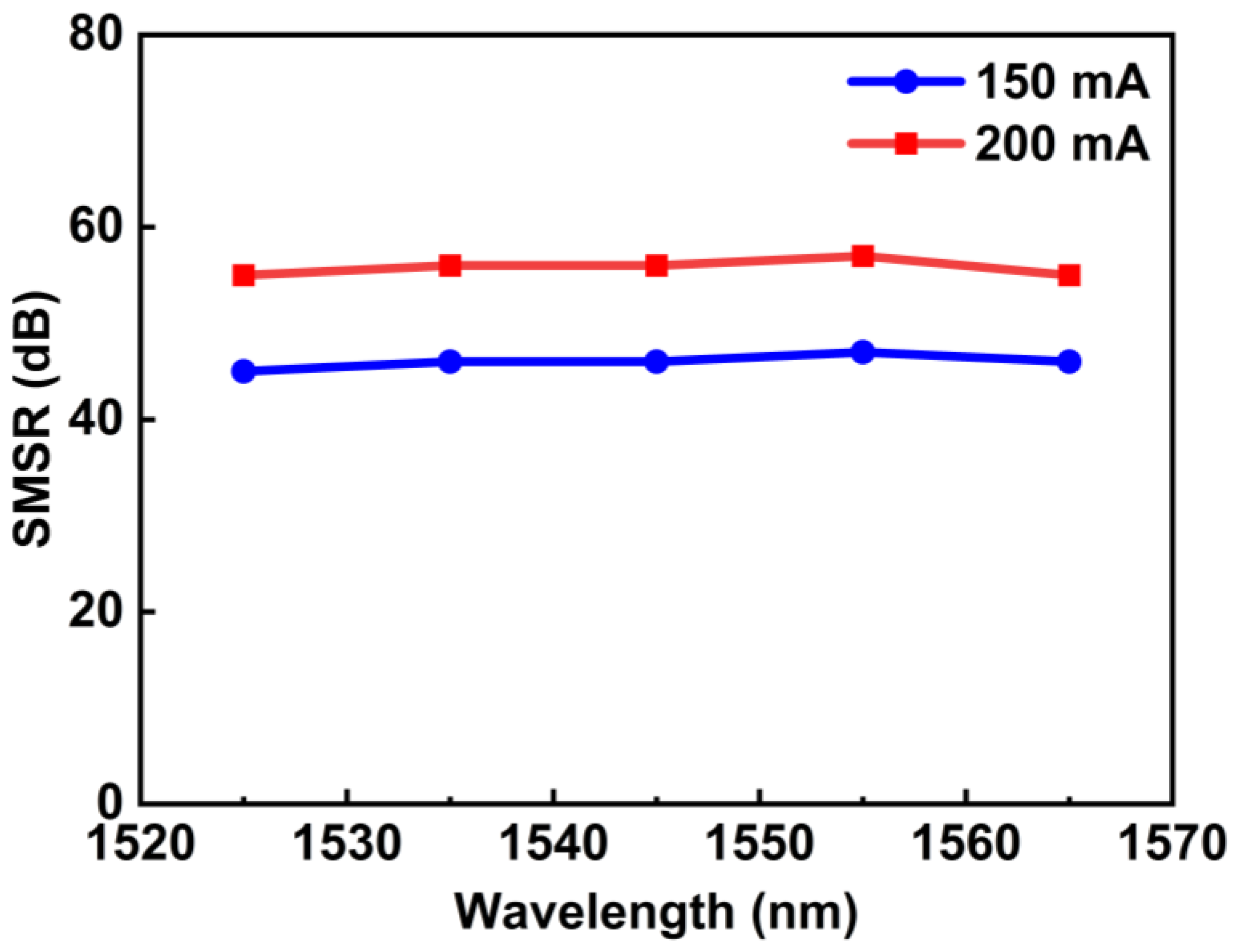Tunable Narrow Linewidth External Cavity Diode Laser Employing Wide Interference Filter and Diffraction Grating
Abstract
:Featured Application
Abstract
1. Introduction
2. Experimental Setup
3. Spectral Linewidth
4. Results and Discussion
4.1. Tunable Optical Spectra
4.2. The Linewidth
4.3. The Threshold Current
4.4. The Side Mode Suppression Ratio
4.5. The Output Power
5. Conclusions
6. Patents
Author Contributions
Funding
Institutional Review Board Statement
Informed Consent Statement
Data Availability Statement
Conflicts of Interest
References
- Galbacs, G. A review of applications and experimental improvements related to diode laser atomic spectroscopy. Appl. Spectrosc. Rev. 2006, 41, 253–303. [Google Scholar] [CrossRef]
- Affolderbach, C.; Mileti, G. A compact laser head with high-frequency stability for Rb atomic clocks and optical instrumentation. Rev. Sci. Instrum. 2005, 76, 073108. [Google Scholar] [CrossRef]
- Laurila, T.; Cattaneo, H.; Koskinen, V.; Kauppinen, J.; Hernberg, R. Diode laser-based photoacoustic spectroscopy with interferometrically-enhanced cantilever detection. Opt. Express. 2005, 13, 2453–2458. [Google Scholar] [CrossRef]
- Kielinski, D.; Cetina, M.; Cox, J.A.; Kärtner, F.X. Laser cooling of trapped ytterbium ions with an ultraviolet diode laser. Opt. Lett. 2006, 31, 757–759. [Google Scholar] [CrossRef]
- Hang, G.; Ari, N.; Tal, G.; Yang, J.; Saeed, F.; Alexandre, H.; Tam, N.; Jose, R.; Shi, R.; Michael, C.; et al. Widely-tunable, narrow-linewidth III-V/silicon hybrid external-cavity laser for coherent communication. Opt. Express 2018, 26, 7920. [Google Scholar]
- Lewoczko-Adamczyk, W.; Pyrlik, C.; Häger, J.; Schwertfeger, S.; Wicht, A.; Peters, A.; Erbert, G.; Tränkle, G. Ultra-narrow linewidth DFB-laser with optical feedback from a monolithic confocal Fabry-Perot cavity. Opt. Express 2015, 23, 9705–9709. [Google Scholar] [CrossRef] [PubMed]
- Wang, Y.; Wu, H.; Chen, C.; Zhou, Y.; Wang, Y.; Liang, L.; Tian, Z.; Qin, L.; Wang, L. An Ultra-High-SMSR External-Cavity Diode Laser with a Wide Tunable Range around 1550 nm. Appl. Sci. 2019, 9, 4390. [Google Scholar] [CrossRef]
- Biebersdorf, A.; Lingk, C.; Giorgi, M.; Feldmann, J.; Sacher, J.; Arzberger, M.; Ulbrich, C.; Bohm, G.; Amann, M.; Abstreiter, G. Tunable single and dual mode operation of an external cavity quantum-dot injection laser. J. Phys. D 2003, 36, 1928–1930. [Google Scholar] [CrossRef]
- Saliba, S.; Scholten, E. Linewidths below 100 kHz with external cavity diode lasers. Appl. Opt. 2009, 48, 6961–6966. [Google Scholar] [CrossRef]
- Chi, M.; Jensen, O.; Petersen, P. High-power dual-wavelength external-cavity diode laser based on tapered amplifier with tunable terahertz frequency difference. Opt. Lett. 2011, 36, 2626–2628. [Google Scholar] [CrossRef] [PubMed]
- Zhang, D.; Zhao, J.; Yang, Q.; Liu, W.; Wang, L. Compact MEMS external cavity tunable laser with ultra-narrow linewidth for coherent detection. Opt. Express 2012, 20, 19670–19682. [Google Scholar] [CrossRef] [PubMed]
- Loh, H.; Lin, Y.J.; Teper, I.; Cetina, M.; Simon, J.; Thompson, J.K.; Vuletić, V. Influence of grating parameters on the linewidths of external-cavity diode lasers. Appl. Opt. 2006, 45, 9191–9197. [Google Scholar] [CrossRef] [PubMed]
- Alexander, M.; Patrick, B.; Gerhard, B. External cavity diode laser setup with two interference filters. Appl. Phys. B 2016, 122, 298. [Google Scholar]
- Thompson, D.J.; Scholten, R.E. Narrow linewidth tunable external cavity diode laser using wide bandwidth filter. Rev. Sci. Instrum. 2012, 83, 826–889. [Google Scholar] [CrossRef] [PubMed]
- Baillard, X.; Gauguet, A.; Bize, S.; Lemonde, P.; Laurent, P.; Clairon, A.; Rosenbusch, P. Interference-filter-stabilized external-cavity diode lasers. Opt. Commun. 2006, 266, 609–613. [Google Scholar] [CrossRef]
- Zhang, L.; Liu, T.; Chen, L.; Xu, G.; Jiang, C.; Liu, J.; Zhang, S. Development of an Interference Filter-Stabilized External-Cavity Diode Laser for Space Applications. Photonics 2020, 7, 12. [Google Scholar] [CrossRef]
- Li, X.; Liang, L.; Qin, L.; Lei, Y.; Jia, P.; Tang, H.; Yang, C.; Chen, Y.; Wang, Y.; Song, Y.; et al. Development of a High-Power Surface Grating Tunable Distributed-Feedback Bragg Semiconductor Laser Based on Gain-Coupling Effect. Appl. Sci. 2022, 12, 4498. [Google Scholar] [CrossRef]
- Zhu, N.; Jiang, W.; Zhang, H.; Ke, J.; Han, W.; Chen, W.; Liu, Y.; Wang, X.; Yuan, H.; Xie, L. Lineshape Analysis of the Beat Signal Between Optical Carrier and Delayed Sidebands. IEEE J. Quantum Electron. 2010, 46, 347–353. [Google Scholar] [CrossRef]
- Sato, H.; Ohya, J. Theory of Spectral Linewidth of External Cavity Semiconductor Lasers. IEEE J. Quantum Electron. 1986, 22, 1060–1063. [Google Scholar] [CrossRef]
- Fujita, T.; Ohya, J.; Ishizuka, S.; Fujito, K.; Sato, H. Oscillationfrequency shift suppressionof semiconductor laserscoupled to external cavity. Elecrron. Lett. 1984, 20, 416–417. [Google Scholar] [CrossRef]







| Wavelength (nm) | 1525 | 1535 | 1545 | 1555 | 1565 |
| The SMSR with filter (dB) | 55 | 56 | 56 | 57 | 55 |
| The SMSR without filter (dB) | 54 | 52 | 55 | 54 | 55 |
Disclaimer/Publisher’s Note: The statements, opinions and data contained in all publications are solely those of the individual author(s) and contributor(s) and not of MDPI and/or the editor(s). MDPI and/or the editor(s) disclaim responsibility for any injury to people or property resulting from any ideas, methods, instructions or products referred to in the content. |
© 2023 by the authors. Licensee MDPI, Basel, Switzerland. This article is an open access article distributed under the terms and conditions of the Creative Commons Attribution (CC BY) license (https://creativecommons.org/licenses/by/4.0/).
Share and Cite
Wang, Y.; Ding, K.; Wu, H.; Zhao, T.; Wu, Y.; Cui, Q.; Chen, Y.; Lei, Y.; Qin, L. Tunable Narrow Linewidth External Cavity Diode Laser Employing Wide Interference Filter and Diffraction Grating. Appl. Sci. 2023, 13, 10790. https://doi.org/10.3390/app131910790
Wang Y, Ding K, Wu H, Zhao T, Wu Y, Cui Q, Chen Y, Lei Y, Qin L. Tunable Narrow Linewidth External Cavity Diode Laser Employing Wide Interference Filter and Diffraction Grating. Applied Sciences. 2023; 13(19):10790. https://doi.org/10.3390/app131910790
Chicago/Turabian StyleWang, Yan, Keke Ding, Hao Wu, Tianye Zhao, Yanyan Wu, Qiang Cui, Yongyi Chen, Yuxin Lei, and Li Qin. 2023. "Tunable Narrow Linewidth External Cavity Diode Laser Employing Wide Interference Filter and Diffraction Grating" Applied Sciences 13, no. 19: 10790. https://doi.org/10.3390/app131910790
APA StyleWang, Y., Ding, K., Wu, H., Zhao, T., Wu, Y., Cui, Q., Chen, Y., Lei, Y., & Qin, L. (2023). Tunable Narrow Linewidth External Cavity Diode Laser Employing Wide Interference Filter and Diffraction Grating. Applied Sciences, 13(19), 10790. https://doi.org/10.3390/app131910790








